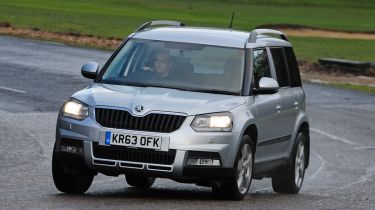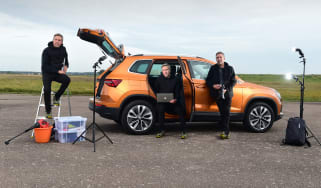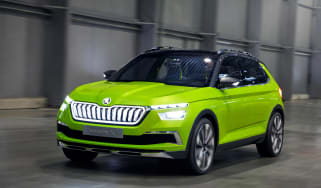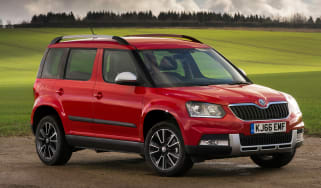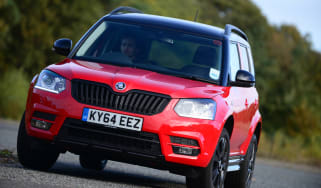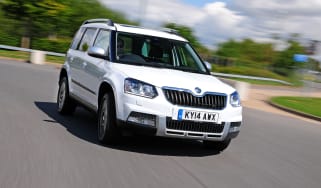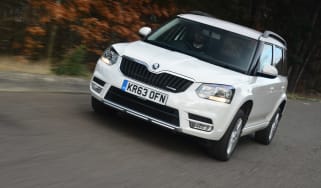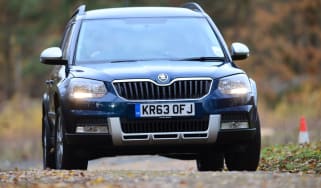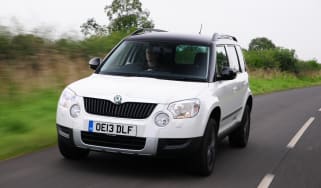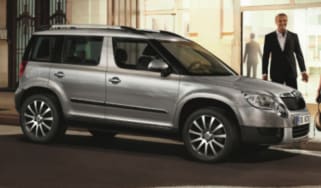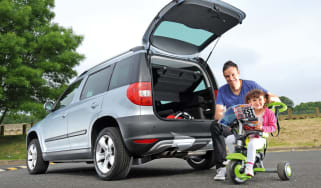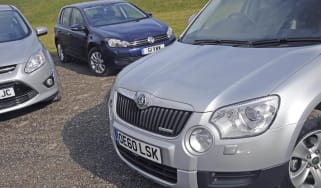Skoda Yeti (2009-2017) review
Skoda’s first crossover gained a cult following with its practical interior, chunky looks and tidy handling

The Yeti is no longer on sale, but it stands as a landmark in Skoda's history. Skoda has replaced it with the Karoq, and to some extent the Kodiaq is a larger alternative, too. However, Skoda’s first crossover remained a competitive model against its newer rivals, with a very likeable, no-nonsense character.
While you might automatically assume that the tough-looking Yeti is best suited to a diesel engine and four-wheel drive, actually it’s the front-drive petrol model that makes the most sense. It has perky performance, surprisingly good real-world fuel economy and is much more refined than the diesel.
If you’re doing big miles or you live at the far end of a rutted track, then fair enough, a diesel 4x4 is best, but for the rest of us the 1.2 TSI will do nicely. It’s a mark of the Yeti’s quality that it remained so competitive in the crossover and compact SUV class after such an extended period on sale, and now it makes a lot of sense as a used family car buy.
The Skoda Yeti is a curiously named family car with plenty to recommend it to the family buyer - despite the oddball name, divisive looks and undesirable badge. It's been a massive success for Skoda since its release, remaining near the top of the class for practicality and value, and holding its own against talented rivals like the Peugeot 2008, Kia Soul and Nissan Qashqai.
Used - available now

2024 Volkswagen
Golf GTI
19,296 milesAutomaticPetrol2.0L
Cash £27,908
2023 Tesla
Model 3
50,319 milesAutomaticElectric
Cash £18,100
2024 BMW
1 Series
7,775 milesAutomaticPetrol1.5L
Cash £19,800
2024 Audi
A3 Sportback
37,675 milesAutomaticPetrol1.4L
Cash £17,800As with many of Skoda's cars, the Yeti operates between two classes of car - bigger than the smallest supermini-SUVs like the Nissan Juke, but smaller than bona fide family crossovers like the Renault Kadjar. It's priced pretty neatly in between them, too, giving family buyers another buying choice.
Since its release, the Yeti's had a minor facelift, which tidied up the front end and removed the bulbous dual headlamp arrangement. It also split the range into regular and Outdoor trim - with the former losing the black plastic body cladding and adopting a more 'on-road' style.
There’s no performance version of the Yeti as such, but buyers can have it in Monte Carlo spec, which has a sporting look thanks to a contrast black finish for the roof, mirrors and the 17-inch alloy wheels. There are also some (faintly silly) fake carbon-fibre inserts and a smaller looking three-spoke steering wheel in the cabin. The standard trim levels run from S and SE to the top spec SE L.
The Skoda Yeti comes fitted with hill descent control and all-wheel drive versions have a sophisticated Haldex clutch design that provides maximum traction when needed. A lighter 4x4 system on the latest models means all-wheel drive versions are slightly more economical than before.
The engine range has also been rationalised, with the old 1.6 TDI 103bhp diesel engine dropped in favour of a 108bhp 2.0-litre TDI unit that’s actually 1g/km better off in emissions terms, and also has a little more torque. There’s a 148bhp diesel too, which can be had with four-wheel drive or a surprisingly frugal 1.2 TSI 108bhp petrol unit. All engines can be had with the optional DSG dual-clutch automatic transmission.
Engines, performance and drive
The Skoda Yeti has always had an edge over its crossover rivals when it comes to driving dynamics and as the updates were so minimal the revised car maintained this advantage. Aside from its higher driving position, the Yeti feels just like a regular family hatchback when you’re behind the wheel.
There’s excellent grip, sharp steering and far less body roll than in the Nissan Qashqai, while the Yeti’s lively nature means it’s far more fun in corners than any crossover has any right to be, even if its steering doesn’t feel quite so well resolved as that of the Qashqai.
The pay-off is a slightly firmer ride quality than in rivals, although you really wouldn’t call it uncomfortable. The Skoda is just as happy cruising at motorway speeds as it is tackling the cut and thrust of urban driving.
Opting for four-wheel drive gives this family crossover excellent grip in mud, snow or other rough terrain, while the system also softens throttle response to minimise wheel spin and helps the car to descend steep hills in a slow and controlled fashion. An off-road button on the dash automatically controls the traction control, hill descent control and braking and it means the Yeti is incredibly simple to drive off-road - sorting out most problems and lack of grip without you even realising there was an issue.
The only problem is that the tall and boxy design is bad for aerodynamics, so there is quite a lot of wind and road noise at motorway speeds, and the diesel engines are quite loud and rumbly - the 1.2 TSI engine is definitely the one to go for if you're looking for a quiet and refined town car.
Engines
The 1.2 TSI turbo petrol engine is a decent performer. It doesn’t feel out of its depth in such a large car, and good mid-range torque means there’s plenty of pulling power when you need it. The engine will be a little underpowered when the Yeti is fully loaded, but most of the time it’s more than capable.
With the demise of the 1.6 diesel and 1.8 turbo petrol options, the only choice for more power in the Yeti is to go for the 2.0-litre diesel in either 108- or 148bhp forms. The more powerful engine comes with 340Nm of torque, 90Nm more than the 108bhp version, which will come in very handy if you’re using the Yeti to haul heavy loads, tow anything or you've bought a 4x4 model with some proper off-roading in mind. If you’re just using it to cruise the motorway network, then the 108bhp version is just fine and you’ll only feel the relative lack of torque if the car is fully laden.
On both engines, the standard six-speed manual transmission is just fine – slick and easy to use - but the DSG dual-clutch automatic option is losing its once-unassailable lead in the sector. Newer transmission designs (ZF’s brilliant eight-speed conventional automatic for instance) are now making the DSG feel a little slow to kick-down and occasionally lost looking for the right gear. It’s a good option for town-dwellers, less so for those looking for a little driver engagement.
MPG, CO2 and Running Costs
Here’s where the Yeti trips up a little compared to newer rivals. Although the latest-generation Volkswagen Group engines have been transplanted in, and some of the older units like the 1.6 TDI and 1.8 TSI have been dropped, the fact is that the Yeti’s older design means it can’t compete when it comes to emissions.
The core Nissan Qashqai 1.5 dCi diesel has 99g/km emissions and therefore free road tax for the first year, and that’s something that shows the Yeti in quite a poor light. The greenest version is now the 108bhp 2.0-litre TDI diesel and that can manage, at best, 118g/km, which means paying £30 a year to keep it taxed. It’s hardly an outrageous amount, but it gives other crossovers a clear advantage.
The petrol Yeti, in spite of it being our favourite engine overall, is worse off again. A rating of 128g/km means it will cost £110 a year to tax, a figure that increasingly looks a bit hefty.
Official combined cycle economy figures are 51mpg for the 1.2 TSI petrol and 62mpg for the 108bhp diesel, but in reality most will probably get closer to 40mpg in daily driving. That’s still not too bad though, and a diesel Yeti should go at least 450 miles between fills, maybe a little further if you’re careful and keep the air conditioning switched off.
Incidentally, Yetis now come optionally with a new app called Smartgate that links to phones and tablets and can download driving data for review later. That might help owners tweak their driving style to extract a few more mpg. All Yetis come with stop-start, brake energy recuperation and a gearshift indicator to help keep things as economical as possible.
Insurance groups
Yetis range from a low of insurance group 13 for the 1.2 petrol to a high of between 18 and 22 for the higher-powered diesels and Monte Carlo models.
All versions are fitted with a tilt-sensor alarm along with curtain airbags, passenger-airbag cut-off, electronic stability control and front fog lights. There’s also a tyre pressure monitor and Isofix child seat anchors for the outer rear seats. SE-L models get cornering fog lights.
Depreciation
In spite of its ageing design, the Yeti remains a car that’s strongly in demand on the used market and that goes pretty much equally for petrol and diesel models, although the higher-spec 4x4 versions might be slightly harder to sell on – Skoda buyers still look at pricing first.
Overall depreciation runs out at approximately 48 per cent retained value after three years, which is at the higher end of the market for a brand such as Skoda.
To get an accurate valuation on a specific model check out our free car valuation tool...
Interior, design and technology
A reputation for putting function over form hasn’t stopped Skoda from cutting a dash in the crossover class with the Yeti.
Rather than go for a soft, rounded look like the Qashqai, the Yeti has raided the off-roader wardrobe and adopted full-on 4x4 styling. For the latest model, there’s a new nose featuring a wider grille with distinctive bonnet peak. The lights are reminiscent of the Octavia hatchback’s, but the rest of the car remains largely the same as the original Yeti.
The upright body, tall roof, chunky roof rails and vertical tailgate mean the Skoda stands taller and looks boxier than its rivals. As a result, it stands out from the crowd.
Since its most recent update, the Yeti has been offered in two distinct model lines. The standard Yeti comes with body-coloured lower bumpers and sills, while the Yeti Outdoor version gets traditional black plastic cladding and front and rear bumpers that have been optimised to give the best departure and approach angles when off-roading.
Inside, there's a relatively plain, but still attractive, fascia made of rugged, yet still soft-touch, materials. Like the Skoda brand itself, the Yeti is all about form following function. There’s little in the way of fripperies, but the ergonomics are generally excellent, the driving position high-set but comfy and the overall sense of quality is really very good. Higher-spec Yetis can actually feel quite plush, in fact.
On the outside, while the black-roofed Monte Carlo editions look pleasingly mean, we’d avoid the white-roof option (it looks a touch silly) and there are some seventies-style beiges and browns that are probably best left in the catalogue and away from the road.
Sat-nav, stereo and infotainment
The only flaw in the Yeti’s interior is that it’s soldiering on with the older-tech Volkswagen Group sat-nav and infotainment. OK, so that’s the definition of a first-world problem but it’s certainly less slick and overall less capable than the newer systems seen in the likes of the Fabia, Octavia and new Superb.
The Yeti’s touchscreen system is simple enough to use and it works just fine, but there’s none of the slick menu controls and expensive-looking graphics that you get with the latest Skoda models. A five-inch touchscreen, with Bluetooth, is standard while more expensive models get a larger 6.5-inch screen and DAB. The basic system comes with a slot for an SD memory card, a USB port, an aux-in socket and two 12v power sockets: one in the dash, one in the boot.
Practicality, comfort and boot space
The Yeti’s square, upright styling plays dividends when you get inside – it’s very spacious for what is really quite a compact car on the outside. As standard, with a spare wheel, the boot has 416 litres of luggage capacity and if you fold the back seats that can be expanded to 1,580 litres, which is pretty good.
The Yeti has an extra trick though, as all three rear seats, which can be individual tumbled and folded, also remove individually (be careful – they’re quite heavy). That operation gives an extra 180 litres of load space, bringing the total to 1,760 litres. On some models, a folding front passenger seat is also available, making it easier to load long items.
Dimensions and size
With a ride-height of 180mm, the Yeti proves itself to be a proper crossover and if you go for the Outdoor version, with its cut-back bumpers, you’ll actually be able to scramble up and down some seriously tough terrain. The height also means that the loading lip of the boot is at a nice level for putting in heavy objects – if you’re of average height, it’ll be more or less at your waist level.
The space inside is tall and mostly square, with no major intrusions or obstructions, although there are some wide gaps between the floor and the backs of the folded seats.
Leg room, head room & passenger space
Space in the back seats is a Yeti strong point, as long as you’re only carrying two rear passengers. The back of the centre rear seat can be folded down to make a tray table with integrated cup holders (although it does leave a gap leading into the boot) and if you lift out the middle seat entirely, the two outer seats slide in and back a little to give a touch more leg- and shoulder room. That centre rear seat is just too narrow to be of much use for sitting in though – it’s effectively a jump seat for short journeys.
Growing families will be frustrated with the back seats – there are only Isofix anchors for the two outer rear seats, and the centre rear seat is too narrow to fit a bulky child car seat. Skoda has a larger, seven-seat SUV in the works. For families with more than two kids, it can’t come soon enough.
Up front, comfort levels are extremely good – the seats are supportive but not over-firm, and the driving position is high enough to give good visibility but not so high that you feel perched up like a van driver.
Some rivals do offer a bit more space in the back, but the Yeti’s deep glass area actually makes it feel more spacious than it is, which is good news if you’re lugging kids around.
Boot space
It’s not the biggest boot in the class at 416 litres but the Yeti’s square shape means its boot is versatile. You can even buy add-on extras such as deep luggage nets and baskets, dog guards and even an internal bike rack for handling the detritus of your life.
There is, however, no getting away from the fact that the current Nissan Qashqai, the Yeti’s most serious rival, beats it for boot space by 15 litres. Not much, but it can make a difference.
Towing
Depending on the engine, the Yeti can handle a maximum internal payload of 645kg while the maximum towing weight, braked, is 2,100kg (for the 2.0-litre diesel). However, there are other options which will offer a slightly reduced maximum towing capacity. For example, those not wanting four-wheel drive can look at the 109bhp 1.2-litre TSI petrol which drives the front wheels only, but has a reduced towing capacity of 1,500kg.
Reliability and Safety
The Yeti was actually the top-rated SUV in the Auto Express Driver Power rankings in 2013 and by 2015 it had only slipped to 2nd place, so it’s not a car that’s likely to give much bother.
Owners gave the car top marks in almost every individual category and it was the top model for reliability, handling and ease of driving. Average running costs and impressive in-car technology also counted in the Yeti's favour, while drivers love the peace of mind that comes with the car's standard safety features, which include ABS and ESP, plus front, side and curtain airbags.
The Haldex 4x4 system in the facelifted car has been seen before in the Octavia 4x4 - so it shouldn't cause any problems - but the new fog light design has moved them into the path of danger for small shunts and scrapes when you are driving off-road.
The Yeti gets a five-star Euro NCAP crash test rating, and comes with the usual selection of airbags and electronic aids, although rear side airbags are a £295 option and such niceties as a city braking system are thus far unavailable.
Warranty
The standard Skoda warranty carries unlimited mileage for the first two years, but is limited to 60,000 miles in the third year. Buyers can extend the warranty out to as much as five years though, at a cost of £630, and there’s a three-year, 30,000-mile service package for £479.
Skoda also provides its own ‘E-Surance’ package as part of the warranty, which guarantees that your Yeti, if damaged in an accident, will be repaired at a Skoda main dealer no matter what your personal insurance policy stipulates. There’s also a three-year, Europe-wide roadside recovery package as standard, and a 12-year anti-perforation warranty.
Servicing
The Yeti comes with its own on-board electronic diagnostics, which will indicate when you need to service the car, usually at 20,000-mile intervals. Skoda does recommend that owners bring it in every 10,000 miles if mileage is low, or if you’re doing lots of rough-tough driving such as off-roading or towing.

